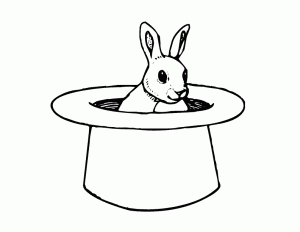Rabbit in the hat…and the pot
I have always been impressed by New Zealand’s canny invention of names when marketing food products. There was the tamarillo that had previously been the tree tomato, the Chinese gooseberry that became the Kiwi fruit and the New Zealand White (rabbit)… a large bunny bred for the plate.
We are not talking the Killer Rabbit of Caerbannog of Monty Python’s Holy Grail fame that required the Holy Hand Grenade of Antioch to bring about its demise. We are talking about one of the main meat rabbit breeds which was actually developed in California. These aren’t the feral type that cost Australia some $600 million per year from crop damage (ten rabbits eat as much as one sheep) but the farmed fatties that appear on menus as coniglio, lapin, or maybe conejo.
It’s hard to imagine that the fearless Vikings who swept all before them were terrified of rabbits as were many people in the Middle Ages. A number of medieval cathedrals in Europe depict demonic rabbits dragging sinners to hell or hanging them. The Vikings and the Celts associated them with the underworld or otherworld because they live underground.
England’s rabbits, the ones that so scared the Vikings, arrived with the Romans who had domesticated them for food from wild Spanish stock. Roman culinary historian Apicius has numerous recipes for them in his annals: “Truss your rabbits short, put them into plenty of water and boil them half an hour; if a large one three quarters; smother them with an onion sauce, and send up liver sauce in a boat.” Therapeutically, rabbit meat was also prescribed for sexual deficiencies in ancient Rome as the rabbit was associated with the goddess Venus as a symbol of sensuality and fertility. Their meat was also supposed to improve one’s looks and make one beautiful and gracious. Perhaps an impossible overbite and big feet were an attribute then.
Mind you, newborn rabbits or rabbit fetuses, known as laurices, were considered a delicacy in Rome while in the Middle Ages monks ate unborn and infant rabbits as these were not considered meat so it could be eaten during fasts.
Mainland Australia, however, encountered its lagomorph epidemic courtesy of the Victorian Acclimatisation society when two dozen were introduced to a property for sport in 1859. They have been a pest ever since, only enjoying a short period of approval in the hey day of the rabitter during the depression when they were trapped, skinned and sold door to door in towns and cities. But then, they are the basis of the felt for the famous Aussie military slouch hat and the Akubra …so what do you do? I guess we just keep breeding big fat, juicy New Zealand Whites for the pot and leave the feral thumpers to 1080 poison, the Myxomatosis and Calicivirus…. and Akubra.
